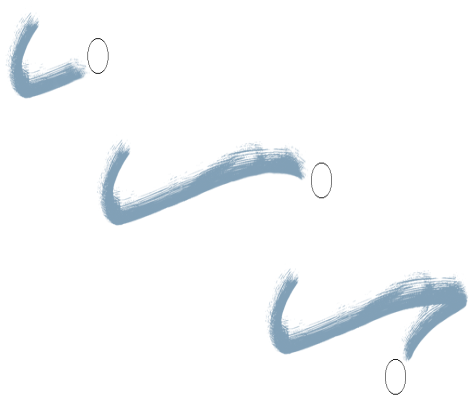Corel Painter Help :
Painting : Recording and playing back brushstrokes
Quick links to procedures on this page:
Corel Painter plays back any stroke you record, wherever you click in the document window. In this way, you can easily create a series of identical strokes — for example, when you create hatching effects.
A brushstroke (top) is recorded and played back within a triangular selection.
Another way to use a recorded stroke is with Auto Playback, which lets you repeat the recorded stroke at random positions on the page.
You can also save recorded strokes for later use. You can play back saved strokes, and you can paint with the data from a saved stroke. This way of working can be particularly useful if you work sometimes with a stylus and sometimes with a mouse: you can record the brushstrokes you make with a stylus, save them for later use, and then use a mouse to obtain the data from that stroke, allowing stylus-quality results.
Corel Painter has a number of brushstroke scripts that can be played back on their own or used in conjunction with an original brushstroke. When you use a brushstroke script, your freehand brushstrokes adhere to the stroke data in the script. This allows you to emulate features of a tablet and stylus while using a mouse.
| • |
Choose Brushes  Record Stroke. Record Stroke. |
| 1 . |
Choose Brushes  Playback Stroke. Playback Stroke. |
| 3 . |
Choose Brushes  Playback Stroke to turn off playback. Playback Stroke to turn off playback. |
| • |
Choose Brushes  Auto Playback. Auto Playback. |
| 1 . |
Choose Brushes  Save Stroke. Save Stroke. |
| 2 . |
In the Save Stroke dialog box, type a name. |
| • |
Choose Brushes  Strokes, and choose a saved stroke. Strokes, and choose a saved stroke. |
| 1 . |
Choose Brushes  Strokes, and choose one of the following: Strokes, and choose one of the following: |
|
• |
Size/Tilt Modulate — varies the size of the brush tip and tilt of the stylus in a brushstroke |
|
• |
Fade In/Out — the start point and endpoint of a brushstroke |
| 2 . |
Choose Brushes  Use Stroke Data. Use Stroke Data. |
